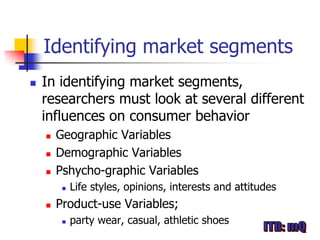Chap11understandingmarketingprocessesandconsumerbehavior 120510232142-phpapp02
- 1. Chapter 11 Understanding Marketing Processes and Consumer Behavior http://www.slideshare.net/Subjectmaterial
- 2. QUIZ 1. WHAT IS THE PRODUCT OF YOUR COMPANY 2. HOW WOULD YOU MAKE PEOPLE BUY/USE YOUR PRODUCT 3. WHAT METHOD OF FOLLOWING WILL YOU USE AND WHY DISTRIBUTION ADVERTISING/ PROMOTION PRICING 2
- 3. Sr. Chapter Chapter Heading No.No. 1. 3 Understanding the Global context of business (031012) 2. 4 Conducting Business Ethically and Responsibly (250212) 3. 6 Organizing the Business Enterprise (030312) 4. 7 Understanding Entrepreneurship and Small Business (100312) 5. 8 Managing Human Resources (240312) 6. 9 Understanding Employee Motivating, Satisfying & Leadership (310312) 7. 11 Understanding Marketing Processes and Consumer Behavior (140412) 8. 16 Managing Quality and Productivity 9. 17 Managing Information Systems and Communication Technology 10. 19 Understanding Money and Banking 11. 20 Intermediate Term and Lease Financing
- 4. FINAL PROJECT GENERATE REVENUE Submit GROUP NAMES Business case with timelines Discuss details registrations
- 5. Marks Distribution 50 Terminal Examination 20 Mid Term Examination 15 Quizzes 15 Final Assignment
- 6. 1. WHAT IS MARKETING 2. TARGET MARKETING AND MARKETING SEGMENTATION 3. MARKETING RESEARCH 4. UNDERSTANDING CONSUMBER BEHAVIOR 5. ORGANIZATIONAL MARKETING AND BUYING BEHAVIOR 6. THE INTERNATIONAL MARKETING MIX 7. SMALL BUSINESS AND THE MARKETING MIX
- 7. WHAT IS MARKETING The process of planning and executing the conception, pricing, promotion, and distribution of ideas, goods and services to create exchanges that satisfy individual and organizational objectives
- 8. Definitions Consumer Goods: Products purchased by consumers for personal use Industrial Goods Products purchased by companies to produce other products Services: Intangible products, such as time, expertise, or an activity, that can be purchased Marketing Plan Detailed and focused strategy for gearing marketing efforts to meet consumer needs and wants
- 9. The Marketing Environment Economic Competitive Technology Customer Social Global
- 10. Elements in the Marketing Mix Product Place Marketing Program Buy at Computers ‘R Us Price Promotion
- 11. The Marketing Mix Marketing Mix: The combination of product, pricing, promotion and distribution strategies used to market products Product: Good, service or idea that is marketed to fill consumer needs and wants Product differentiation: Creation of a product or product image that differs enough from existing products to attract customers
- 12. Pricing Strategy Choosing the right price to attract consumers and meet the firm’s profit goals Price = total value consumers willing to give May be low price strategy (salt) or high price strategy (mink coat) Price must consider all costs operation and administration marketing research advertising
- 13. Promotion Strategy Choosing the right method of communicating information about the product advertising personal selling sales promotions public relations
- 14. Place (Distribution Strategy) The part of the marketing mix concerned with getting the product from producer to buyer Choice of sales outlets Physical transportation Channels of distribution
- 15. TARGET MARKET AND MARKET SEGMENTATION Target Market: A group of people having similar needs and wants and that can be expected to show interests in the same products Market Segmentation Process of dividing a market into categories of customer types and selecting specific segments to pursue
- 16. Identifying market segments In identifying market segments, researchers must look at several different influences on consumer behavior Geographic Variables Demographic Variables Pshycho-graphic Variables Life styles, opinions, interests and attitudes Product-use Variables; party wear, casual, athletic shoes
- 17. MARKETING RESEARCH The study of consumer needs and wants and the ways in which sellers can best meet them 17
- 18. The Research Process Study the Select a Make Collect Analyze Prepare Current Research Recomme Data Data Reports Situation Method ndations Use Use Focus Observatio Experimen Survey Secondary Primary Group n tation Data Data 18
- 19. RESEARCH METHODS 1. Observation Market research technique that involves simply watching and recording consumer behavior 2. Surveys Market research technique using a questionnaire that is either mailed to individuals or used as the basis of interviews 3. Focus Groups Market research technique in which a group of people is gathered, presented with an issue, and asked to discuss it in depth 4. Experimentation Market research technique that attempts to compare the responses of the some of similar people under different circumstances
- 20. UNDERSTANDING CONSUMER BEHAVIOR Personal & Purchase Environmental Marketing Process Factors Factors Problem Product Recognition Psychological Information Seeking Price Personal Evaluation of Alternatives Social Place Purchase Decision Cultural Promotion Post- Evaluation Purchase
- 21. UNDERSTANDING CONSUMER BEHAVIOR Consumer behavior: Various facets of the decision making process by which customers come to purchase and consumer products Brand loyalty: Process of regular consumer purchasing based on satisfaction with a product Purchase decision: Rational motives: Reasons of purchasing a product that are based on a logical evaluation of product attributes Emotional motives: Reasons of purchasing a product that are based on non objective factors
- 22. ORGANZATIONAL MARKETING AND BUYING BEHAVIOR Organizational Markets Industrial markets Reseller markets Institutional markets Organizational buying behavior Specialized buyers Trained in the buyer seller relationships Company specialists Experts about the products 22
- 23. ORGANZATIONAL MARKETING AND BUYING BEHAVIOR Differences in decision making Developing product specifications Evaluating alternatives Making post purchase evaluations
- 24. International Marketing Mix Products may require substantial change before they can be marketed to different countries Pricing requires consideration of product manufacturing costs, transportation and delivery Promotion must accommodate cultural differences and social traditions Distribution may involve cooperation with other international firms and adherence to foreign packaging and labelling legislation
- 25. Small Business Marketing Mix Care must be taken to: offer products to markets substantial enough to support the organization do a complete analysis of costs prior to setting prices develop a comprehensive promotional program using more than personal selling lower cost options: publicity, associated events choose a location that will attract and retain customers
Editor's Notes
- http://www.slideshare.net/Subjectmaterial

























